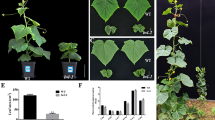Abstract.
A group of frequent cDNA clones from a young-leaf cDNA library was found to code for a homologue of S-ribonucleases (S-RNases) involved in gametophytic incompatibility and the so-called S-like RNases active in flowers and in vegetative tissues. The derived amino acid sequence starts with a signal peptide and has a 27-amino-acid C-terminal extension of unknown function. The barley (Hordeum vulgare L.) gene, rsh1 (for RNase S-like homologue) corresponding to the cDNA clones was isolated. The gene has three introns and the position of one intron corresponds to the site of the single, small intron in the S-RNase genes. The deduced amino acid sequence of mature RSH1 shares 35% identical and 58% similar amino acid residues with an S-like RNase from tomato, RNase LE. However, two active-site histidine residues, conserved between all S and S-like RNases are replaced by serine residues in RSH1. The new barley RNase S-like homologue is clearly related to the family of active RNases but is probably not active as an RNase. Sequences from the same class of presumably inactive RNases have been recorded in maize, rice and sorghum. The barley gene is exclusively expressed in young leaf tissue and is substantially induced by light.
Similar content being viewed by others
Author information
Authors and Affiliations
Additional information
Received: 26 July 1999 / Accepted: 26 October 1999
Rights and permissions
About this article
Cite this article
Gausing, K. A barley gene (rsh1) encoding a ribonuclease S-like homologue specifically expressed in young light-grown leaves. Planta 210, 574–579 (2000). https://doi.org/10.1007/s004250050046
Issue Date:
DOI: https://doi.org/10.1007/s004250050046




